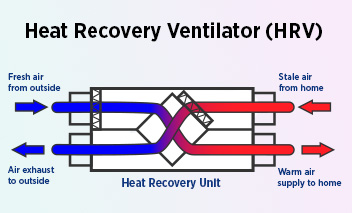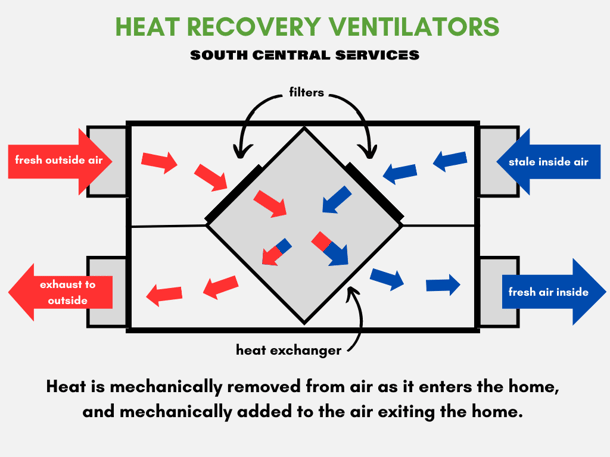HRV vs Other Ventilation Systems: How They Compare
Wiki Article
Unveiling the Secret Advantages and Uses of Heat Recovery Ventilation in Lasting Style
Heat Recovery Ventilation (HRV) systems play an important duty in lasting design. They facilitate a continual exchange of stale interior air with fresh outside air, considerably enhancing interior air high quality. HRVs add to energy efficiency by redeeming warmth from exhausted air, which can reduce energy costs. Understanding the multifaceted advantages and applications of HRVs reveals their value in contemporary architecture. What various other advantages do these systems supply in the search of sustainability?Comprehending Heat Recovery Ventilation Systems
Heat recovery ventilation (HRV) systems are created to enhance interior air high quality while reducing energy loss. These systems use a mechanical air flow strategy to exchange stale indoor air with fresh outdoor air, making sure a continuous supply of tidy air. By capturing heat from the exhaust air, HRVs prerequisite incoming air, reducing the need on heating and cooling down systems. This procedure not just enhances thermal comfort but additionally contributes to power efficiency in domestic and industrial buildings. Additionally, HRV systems assist manage moisture degrees and reduce indoor contaminants, advertising a much healthier living setting. Their strategic application is crucial for achieving sustainable design goals, as they provide an equilibrium between energy conservation and resident well-being.How HRV Solution Work
While lots of might recognize with air flow systems, recognizing just how warmth recuperation air flow (HRV) systems operate is important for appreciating their advantages. HRV systems work by exchanging stale interior air with fresh exterior air while moving warm between the two streams. This procedure takes place in a warm exchanger, where warmth from the outgoing air warms up the incoming air throughout cooler months, lessening power loss. Conversely, in warmer months, the system can cool incoming air making use of the cooler outbound air. HRVs are outfitted with followers to facilitate air flow and filters to remove particulates, ensuring a continuous, well balanced air flow process. This cutting-edge style not only enhances power performance however additionally adds to keeping a comfortable indoor setting.Enhancing Indoor Air High Quality
Indoor air top quality can substantially influence health and wellness and wellness, making efficient ventilation crucial in modern homes. Heat Recovery Ventilation (HRV) systems play a vital duty in preserving interior air high quality by constantly exchanging stale indoor air with fresh exterior air. This process not only minimizes airborne pollutants yet also decreases humidity degrees, which can result in mold and mildew development and breathing issues. HRV systems filter incoming air, getting rid of allergens and particulates, thereby supplying a healthier living setting. Furthermore, these systems aid eliminate smells and unstable natural compounds (VOCs) frequently found in family products. By making certain a consistent circulation of clean air, HRV systems add to a general better indoor atmosphere, promoting convenience and well-being for residents.Power Efficiency and Expense Financial Savings
Energy efficiency sticks out as a substantial advantage of Heat Recovery Ventilation (HRV) systems. By capturing and reusing the heat from exhausted indoor air, HRVs reduce the energy needed for heating inbound fresh air, leading to decreased energy consumption. This effectiveness converts into lower utility costs, supplying substantial cost savings for property owners and services alike. In addition, HRV systems frequently get approved for energy performance incentives and refunds, even more boosting their economic allure. Gradually, the initial financial investment in HRV innovation can cause a positive return on financial investment through lowered power costs. The assimilation of HRV systems not only advertises sustainable style yet likewise offers a functional service for attaining lasting power financial savings and economic benefits.Environmental Advantages of HRV

A multitude of ecological advantages develops from the application of Heat Recovery Ventilation (HRV) systems. By effectively transferring warm from exhaust air to inbound fresh air, HRVs substantially minimize the energy needed for heating and cooling down rooms. This energy effectiveness equates to lower greenhouse gas emissions, adding to a reduction in the general carbon footprint of buildings. In addition, HRV systems enhance indoor air top quality by constantly circulating fresh air, therefore minimizing the concentration of interior pollutants and allergens. The decrease in energy usage help in saving all-natural resources, making HRVs an essential component of sustainable design. Generally, the environmental advantages of HRVs play an essential role in promoting a much healthier world and cultivating eco-friendly building practices.
Versatile Applications in Modern Design
Heat recovery ventilation (HRV) systems are increasingly being integrated right into both property and commercial architectural tasks. In property settings, HRVs enhance indoor air high quality while maximizing power performance. In industrial areas, these systems optimize air flow techniques, showing their adaptability in modern-day building applications.Residential Projects Integration
While contemporary style increasingly stresses sustainability, the combination of heat healing ventilation systems in property jobs has actually emerged as a useful option for boosting interior air top quality and energy efficiency. These systems efficiently transfer warm from exhaust air to incoming fresh air, lessening power loss and minimizing home heating or cooling down needs. In brand-new builds and retrofits alike, warm healing air flow can be perfectly integrated, supplying homeowners with a much healthier living setting while decreasing energy expenses. Furthermore, with boosting understanding of ecological effects, more architects and builders are identifying the lasting benefits of these systems. Therefore, heat recuperation air flow has become a crucial part of lasting domestic design, showcasing versatility and dedication to eco-friendly techniques.Business Areas Optimization
As modern business areas develop to meet the needs of sustainability and effectiveness, the execution of heat healing ventilation systems becomes a key approach for maximizing indoor atmospheres. These systems help with the exchange of stale indoor air with fresh exterior air while redeeming warmth energy, significantly minimizing energy intake. This not only improves comfort for occupants yet likewise assists in reducing functional prices. Flexible applications can be observed in workplaces, retail spaces, and educational organizations, where air quality and temperature level control are paramount. In addition, integrating warm recuperation ventilation lines up with green structure qualifications, further advertising environmental responsibility. Eventually, embracing such systems in commercial design not only adds to sustainability objectives however also cultivates healthier, a lot more effective rooms for customers.
Integrating HRV Into Sustainable Design Practices
Integrating warm recuperation ventilation useful link (HRV) systems into lasting style practices provides considerable benefits in power performance and indoor air quality. By using HRV, developers can develop cost-efficient remedies that not only minimize energy consumption but also boost the total convenience of indoor environments. This alignment with sustainability goals placements HRV as an important component in modern-day building techniques.
Energy Efficiency Enhancement
By including warmth recuperation air flow (HRV) systems into lasting style techniques, engineers and home builders can substantially improve power effectiveness in modern-day buildings. HRV systems operate by capturing warm from outbound stagnant air and transferring it to incoming fresh air, reducing the energy required for home heating or cooling indoor areas. This process not only lowers reliance on conventional heating and cooling systems however also decreases total energy usage. Additionally, HRV systems can aid preserve a regular indoor temperature, reducing peak power needs. By incorporating these systems, structures can attain considerable reductions in utility expenses and carbon impacts, aligning with sustainability objectives. Eventually, HRV innovation stands for a practical solution for improving power effectiveness in the built setting, advertising more liable resource use.Indoor Air Top Quality Renovation
Just how can heat healing ventilation (HRV) systems add to superior interior air high quality in contemporary structures? HRV systems efficiently exchange stale interior air with fresh important link exterior air while recouping heat, decreasing temperature level fluctuations. This procedure reduces the concentration of indoor pollutants, such as volatile natural compounds (VOCs), allergens, and wetness, which can deteriorate air high quality and impact passenger wellness. By keeping ideal moisture degrees and guaranteeing a continual supply of tidy air, HRVs aid produce a much healthier interior setting. Furthermore, these systems can be integrated into sustainable style techniques, promoting power efficiency alongside boosted air top quality. HRV Heat Recovery Ventilation. Subsequently, HRV modern technology plays an essential function ahead of time general passenger comfort and well-being in contemporary architectural layoutsCost-efficient Style Solutions

Frequently Asked Questions
What Upkeep Is Required for Heat Recovery Ventilation Solutions?

Maintenance for warm healing air flow systems commonly includes normal filter substitutes, cleaning of warm exchangers, assessment of followers and air ducts, and making sure correct drainage. These jobs help keep efficiency and extend the system's life expectancy with time.
Can HRV Systems Be Mounted in Existing Buildings?
Heat recovery ventilation systems can indeed be installed in existing buildings. HRV Heat Recovery Ventilation. Retrofitting needs careful preparation and evaluation of the structure's format, making sure compatibility with present systems while taking full advantage of power performance and indoor air top qualityExactly How Do HRV Systems Influence Sound Levels Indoors?
HRV systems can affect interior sound degrees by introducing noise from outside resources through air flow. Premium setups usually include sound-dampening functions, decreasing noise effect while providing reliable air exchange and maintaining comfort inside.Are There Any Downsides to Making Use Of HRV Systems?
The drawbacks of making use of HRV systems consist of potential high first expenses, upkeep obstacles, and the possibility of reduced interior air quality if filters are not on a regular basis altered, which could bring about issues with try this out humidity levels.Just how Do I Pick the Right HRV System for My Demands?
Picking the right heat recovery ventilation system entails evaluating particular needs, such as building dimension, environment, and power effectiveness objectives. Additionally, reviewing system attributes, setup requirements, and maintenance considerations is important for peak performance and contentment.Report this wiki page